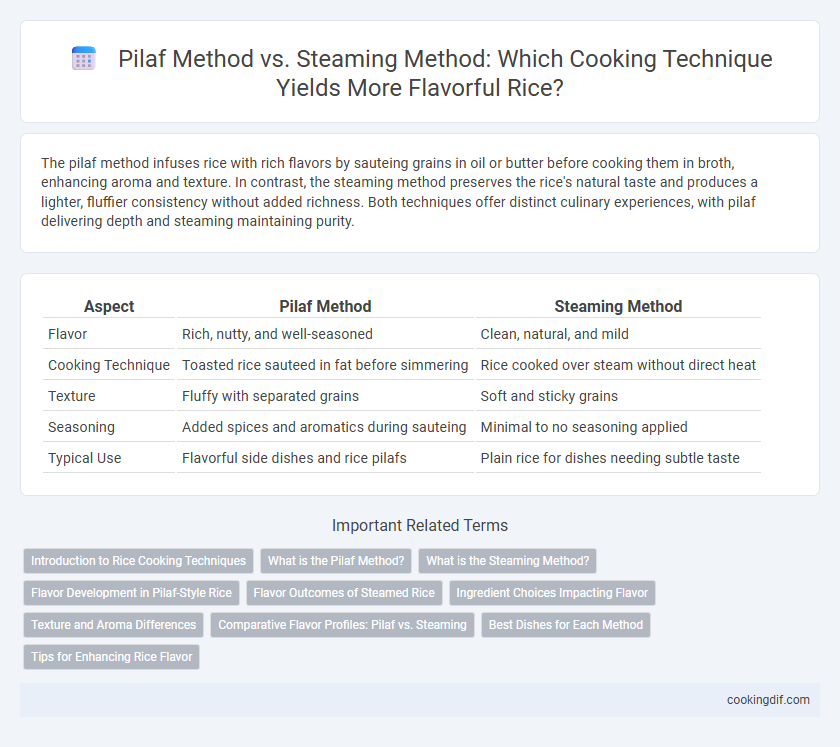The pilaf method infuses rice with rich flavors by sauteing grains in oil or butter before cooking them in broth, enhancing aroma and texture. In contrast, the steaming method preserves the rice's natural taste and produces a lighter, fluffier consistency without added richness. Both techniques offer distinct culinary experiences, with pilaf delivering depth and steaming maintaining purity.
Table of Comparison
| Aspect | Pilaf Method | Steaming Method |
|---|---|---|
| Flavor | Rich, nutty, and well-seasoned | Clean, natural, and mild |
| Cooking Technique | Toasted rice sauteed in fat before simmering | Rice cooked over steam without direct heat |
| Texture | Fluffy with separated grains | Soft and sticky grains |
| Seasoning | Added spices and aromatics during sauteing | Minimal to no seasoning applied |
| Typical Use | Flavorful side dishes and rice pilafs | Plain rice for dishes needing subtle taste |
Introduction to Rice Cooking Techniques
The Pilaf method enhances rice flavor by sauteing grains in oil or butter before simmering in broth, allowing spices and aromatics to infuse fully. Steaming preserves the natural taste and texture of rice, ideal for delicate varieties like basmati, but lacks the depth added by the pilaf technique. Both methods require precise water ratios and heat control to achieve optimal fluffiness and consistency.
What is the Pilaf Method?
The pilaf method involves sauteing rice in oil or butter before cooking it in broth, which enhances the flavor by toasting the grains and infusing them with aromatic spices. This technique creates a fluffy texture with distinct, separate grains, elevating the overall taste profile compared to steaming. Unlike steaming, pilaf locks in rich flavors by combining fat, heat, and broth, making it a preferred method for savory rice dishes.
What is the Steaming Method?
The steaming method involves cooking rice by exposing it to steam heat, allowing grains to absorb moisture gradually without direct contact with water, which preserves the grain's natural texture and subtle flavor. Unlike the pilaf method, which toasts rice in fat before simmering it in broth to enhance flavor, steaming maintains a clean, light taste ideal for dishes needing a delicate rice base. This technique is especially effective for long-grain varieties like basmati and jasmine, ensuring fluffy, separate grains with a soft aroma.
Flavor Development in Pilaf-Style Rice
Pilaf method enhances flavor by toasting rice grains in oil or butter before cooking, creating a nutty aroma and deeper taste profile compared to steaming. The sauteing process allows the rice to absorb spices and aromatics, resulting in layered flavors that steaming alone cannot achieve. Flavor development in pilaf-style rice intensifies as the grain absorbs broth or seasoned liquid, enriching every bite with savory complexity.
Flavor Outcomes of Steamed Rice
Steamed rice preserves the natural aroma and subtle sweetness of the grain, resulting in a clean and delicate flavor profile. The gentle steaming method prevents the rice from becoming overly starchy or sticky, maintaining individual grains with a light, fluffy texture. This technique enhances pure grain taste and pairs well with dishes that benefit from a neutral, yet fragrant rice base.
Ingredient Choices Impacting Flavor
The pilaf method enhances rice flavor by toasting grains in fat before cooking, allowing spices and aromatics like onions and garlic to infuse deeply. In contrast, the steaming method preserves the natural taste and texture of rice, emphasizing the quality of the rice variety and water used. Ingredient choices such as the type of fat, herbs, and broth in pilaf directly impact the richness and complexity of the final dish.
Texture and Aroma Differences
The pilaf method involves sauteing rice in oil or butter before cooking, which enhances the texture by producing separate, fluffy grains and a richer aroma due to the toasted flavors. Steaming rice preserves moisture, resulting in a softer and stickier texture with a more subtle, natural aroma. Pilaf rice tends to have a nuttier fragrance and firmer bite, while steamed rice emphasizes tenderness and purity of flavor.
Comparative Flavor Profiles: Pilaf vs. Steaming
The pilaf method infuses rice with rich, layered flavors by sauteing grains in fat before simmering them in seasoned broth, creating a nutty, aromatic profile. In contrast, the steaming method preserves the rice's natural, subtle taste and texture by cooking it with minimal seasoning and moisture. Pilaf delivers a more complex and robust flavor, while steaming emphasizes purity and the inherent qualities of the rice grain.
Best Dishes for Each Method
Pilaf method enhances flavor by toasting rice in butter or oil before simmering with broth, ideal for dishes like Middle Eastern pilafs or Spanish paella that benefit from nutty, rich undertones. Steaming preserves the rice's light and fluffy texture, making it perfect for delicacies such as Japanese sushi or traditional Chinese jasmine rice servings where purity and fragrance dominate. Choosing the right method depends on the desired dish complexity and cultural authenticity, with pilaf providing robust flavor and steaming emphasizing natural rice aromas.
Tips for Enhancing Rice Flavor
Pilaf method enhances rice flavor by sauteing grains in oil or butter before cooking, allowing the kernels to absorb aromatic spices and develop a nutty taste. Steaming rice preserves natural flavor and texture, especially when rinsed thoroughly to remove excess starch and soaked briefly for even cooking. For richer flavor, infuse cooking water with herbs, broth, or spices and consider toasting rice lightly before adding liquid.
Pilaf method vs steaming method for flavor Infographic

 cookingdif.com
cookingdif.com